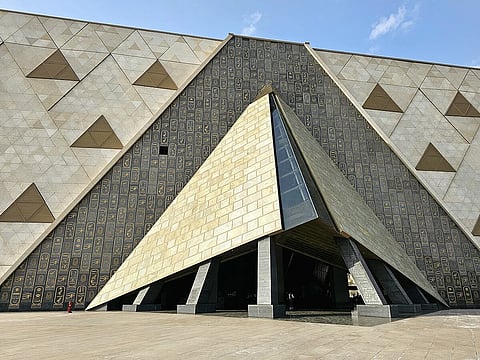
- Home
- न्यूजग्राम
- NewsGram USA
- India
- World
- Politics
- Entertainment
- Culture
- Lifestyle
- Economy
- Sports
- Sp. Coverage
- Misc.
- NewsGram Exclusive
- Jobs / Internships

Key Points
Egypt officially opened the worlds largest archaeological museum – the Grand Egyptian Museum (GEM) – earlier this week.
The museum will house over 50,000 artefacts, and feature artefacts from ancient Egypt, including the entire contents of Tutankhamun's tomb.
The museum aims to revitalize the country's dipping tourism sector which was hampered by regional conflicts and the Covid-19 pandemic.
Egypt has officially opened the worlds largest archaeological museum – the Grand Egyptian Museum (GEM). The $1 billion cultural complex near the Giza pyramids, marking one of the most ambitious archaeological projects in modern history. The vast museum, delayed for nearly two decades, is designed to house more than 50,000 artefacts, offering a unified showcase of the country’s ancient heritage.
Although inaugurated this week, the museum will open its doors to the public on 4 November 2025, coinciding with the anniversary of the discovery of Tutankhamun’s tomb in 1922.
Among its main attractions is the full collection of treasures from the tomb of Pharaoh Tutankhamun, displayed together for the first time since their discovery. The exhibit includes around 5,000 items, from the iconic gold death mask to chariots, jewellery, and ceremonial furniture – all meticulously restored. Visitors can also view colossal statues, mummies, and monuments from across Egypt, including an 83-tonne, 11-metre statue of Ramses II that dominates the museum’s entrance hall.
Spanning nearly 500,000 m2, the Grand Egyptian Museum is situated 2 km from the Great Pyramid of Giza. It is designed as a large stone building, with glass facades framing views of the Giza pyramids and galleries organized chronologically from prehistoric Egypt to the Greco-Roman period. The museum also includes a 3D cinema, research labs, and conservation centres. As the largest museum dedicated to a single civilisation – the Ancient Egyptians – it is both a public attraction and a hub for archaeological study.
The idea for the GEM was first proposed in 1992, with construction beginning in 2005. Political instability, funding challenges, and the pandemic repeatedly delayed its completion. Japan provided key financial support through loans and technical expertise, and Egypt’s Ministry of Tourism and Antiquities oversaw years of artefact restoration and relocation from the Egyptian Museum in Tahrir Square.
See Also: Egypt film festival showcases women’s resilience through adversity
The opening marks a turning point for Egypt’s tourism industry, which has faced repeated declines over the past decade due to political unrest and global travel disruptions. Authorities hope the new site will help revive the sector, with officials expecting around 15,000 to 20,000 visitors a day. The government aims to roughly double Egypt’s 15.7 million annual tourist figure by 2032. In 2024, tourism accounted for around 8% of the country's GDP. The museum is positioned as a central pillar in efforts to boost international arrivals and rebrand the country as a global cultural destination.
The inauguration drew world leaders, dignitaries, and representatives from UNESCO and international museums, including French President Emmanuel Macron, Jordan’s King Abdullah II. The event featured performances by the Cairo Symphony Orchestra and a multimedia presentation of Egypt’s archaeological legacy.
To support the expected surge in visitors, Egypt has invested heavily in surrounding infrastructure, including a new metro system under construction, an airport that began operations in 2020 near Giza, upgraded roads and hotels, and a pedestrian walkway linking the museum to the pyramids. These efforts aim to make the complex the centrepiece of a broader tourism corridor connecting Cairo’s cultural and heritage sites.
Beyond tourism, the museum’s opening has renewed such appeals for the return of key Egyptian artefacts held abroad – most notably the Rosetta Stone currently on display at the British Museum. Though the British Museum says it has not received a formal repatriation request.
Sherif Fathy, Egypt’s minister for tourism and antiquities, described the opening as a cultural milestone: “It is a gift from Egypt to the world and we are proud to finally share it.” [Rh]
Suggested Reading:
